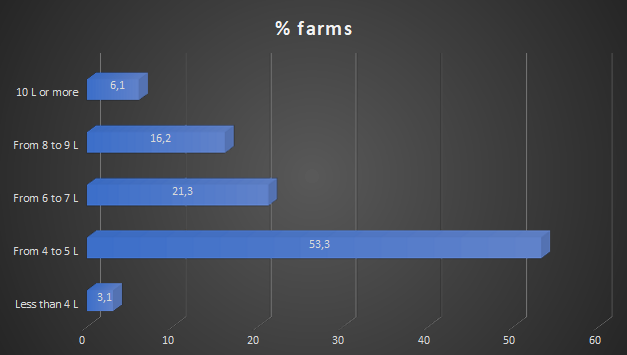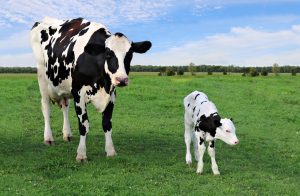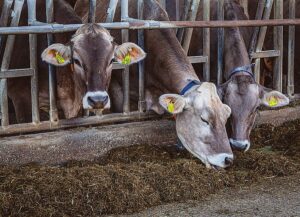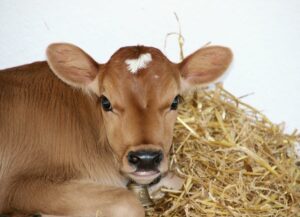Fernando Diaz
The pre-weaning phase is the most important period in young heifer raising. A feeding program for the lactating phase, is mainly composed of milk or milk replacer and a starter ration, and must supply the heifer’s energy and protein needs while promoting rumen development for its adequate functionality post-weaning. Graph number 1 below shows the amount of milk or milk replacer fed to heifer calves in the US. These are the results of a survey on dairy cattle management practices conducted by the US National Animal Health Monitoring System (NAHMS – USDA) and published in 2016. This survey was performed in 17 states that had the greatest milk production representing 76.7 % of the dairy farms and 80.3 % of the US dairy cows.

From what can be observed in the graph, more than half of the farms (56.5%) were feeding 5 or less L of milk. In addition, the authors found differences in management depending on the size of the farm. A smaller number (35%) of large farms with more than 500 cows were feeding this low amount of milk to their heifers, compared to medium sized farms with 100 – 500 cows (54%) and smaller farms with less than 100 cows (55%).
It is well known that administering 4 – 5 L of milk or milk replacer it’s not enough to guarantee adequate growth and, in some instances like with lower ambient temperatures, it may not even fulfill their growth requirements. This lower plane of nutrition may decrease immunity making them more susceptible to infections and even death as a result of not thriving. In addition, a better plane of nutrition before weaning improves development of the mammary gland and increases milk production after their first calving.
Researchers of the University of Minnesota evaluated production data of 2,880 Holstein heifers from 37 research studies (Chester-Jones et al., 2017). They found that daily weight gain (DWG) at 8 weeks of age significantly improved milk production in their first lactation, with each kg of DWG at the 8th week, representing an additional 579 kg of milk. Feeding excess milk, in addition to not being economical, resulted in reduced starter intake and a reduction in rumen development. According to the NAHMS survey discussed above, more than 20% of US dairies offered too much milk (8 L or more) to heifers.
An article published recently in the “Journal of Dairy Science” addressed the effects of feeding moderate or high amounts of milk replacer on the growth of Holstein heifers during their first 16 weeks of age (Hu y col., 2019). During the first 6 weeks the researchers fed calves aged 3 – 4 days two different amounts of milk replacer (690 or 1000 g/day) in two daily meals, plus texturized starter free choice. The calves’ daily weight gains (DWG) during the first 8 weeks was similar between both feeding programs (0.63 kg/day). As expected, calves that received more replacer ate les starter (35% less). In addition, the authors evaluated nutrient digestibility for both group of calves, 51 – 55 days into the experiment. The digestibility of the dry matter (76.5 vs. 70.3%), fiber (37.2 vs. 22.7%) and protein (28.8 vs. 72.6%) was significantly higher in calves that received less replacer. Since they had eaten more dry feed pre-weaning, after weaning these calves digested the nutrients with greater ease compared to those that received more replacer. At the eight-week, calves were reassigned to groups of 4 and fed the same starter mixed with 5% hay up to their 16th week of age. During this period, calves fed less replacer pre-weaning ate a little less starter (2.92 kg/day) than those that received more milk (3.12 kg/day). However, DWG during this period was 9% greater in calves fed less milk (0.99 vs. 0.92 kg/day). These calves grew more and were more efficient since their rumen was more developed.
In conclusion, in a heifer feeding program, grain intake is as important as milk or milk replacer intake. Feeding excessive amounts of milk or replacer limits the rumen development and can affect post-weaning growth. Conversely, minimum amounts of milk (4 – 5 L) are not enough to fulfill their energy requirements. A heifer rearing program that combines a moderate amount of milk (6 – 7 L/day) or replacer (650 – 700 g/day) together with good quality, texturized starter, guarantees adequate growth before and after weaning.
About the author
Fernando Diaz is the Dairy Knowledge Center’s Director. Dr. Diaz works as an independent Dairy Nutrition and Management Consultant. He provides consultation to dairies and feed companies including nutrition and feeding management, forage and crop plans, and research and product development of new feedstuffs, additives and technologies for dairy cows. Fernando lives in Brookings, South Dakota and can be reached at fernando@dairykc.com.
© 2020 Dairy Knowledge Center. All Rights Reserved.











